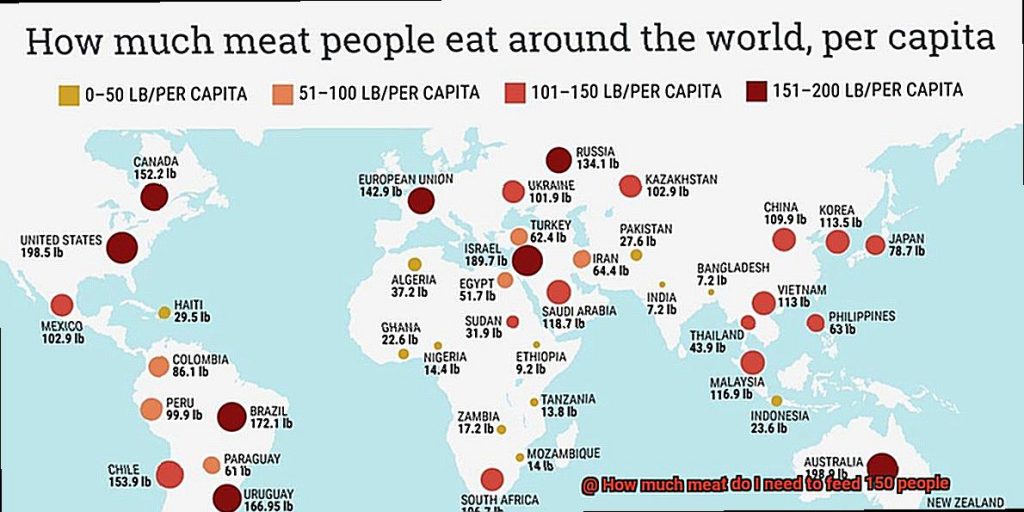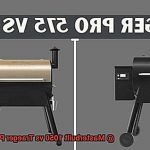Are you gearing up for a grand event or celebration and wondering how much meat you’ll need to satiate your guests? It’s a common question that can be daunting, especially when you’re feeding a large group of people. Whether it’s a wedding reception, corporate gathering, or family reunion, getting the right amount of meat can make all the difference in ensuring your event is a hit.
But fret not. In this blog post, we’ll take you through the process of determining just how much meat you need to feed 150 people. We’ll delve into various factors that could impact your calculations, such as the type of meat, serving size, and dietary restrictions. You’ll discover best practices for estimating the perfect amount of meat per guest and some savvy tips on saving money without compromising quality or flavor.
So if you want to wow your guests and guarantee everyone leaves happy and full, read on to learn how much meat you need to feed 150 people.
Contents
Factors to Consider When Calculating Meat Amounts
Feeding a crowd of 150 people can be quite the undertaking, especially when it comes to calculating the perfect amount of meat needed. But fear not – we’ve got you covered. When determining how much meat to allocate per person, there are several factors that you need to take into account to ensure that everyone leaves satisfied.
The first factor to consider is the type of meat that will be served. Different cuts of meat have varying amounts of meat per pound, so it’s crucial to choose the right cut for your needs. For example, chicken or pork tend to be lighter than beef or lamb, so you may want to allocate slightly less per person if those are your chosen meats.
Next up is serving size. The average serving size for meat is around 4-6 ounces per person, but this can vary depending on the type of meat and your guests’ preferences. If you’re serving a main course with sides, you can likely allocate less meat per person. However, if the meat is going to be the star of the show, then you may want to increase the amount of meat allocated per person.
Another important factor to consider is whether you will be serving other dishes alongside the meat. If you plan to provide side dishes, you may be able to reduce the amount of meat needed per person. Additionally, if you’re opting for a buffet-style meal, keep in mind that guests tend to take larger portions. Therefore, you may need more food than if you were serving plated dinners.
Lastly, it’s crucial to consider any dietary restrictions or preferences of your guests. If vegetarians or vegans will be attending your event, make sure to factor in additional vegetarian or vegan options in addition to meat.
Type of Meat
When it comes to planning a meal for a large group of 150 people, selecting the right type of meat is essential to ensure everyone enjoys their meal. There are several factors to consider when deciding on the perfect meat choice, such as personal preference, budget, and dietary restrictions.
Beef is a classic and popular choice for many events, and there are several different cuts to choose from. If you’re looking for something luxurious and elegant, a whole beef tenderloin can feed around 12-15 people per pound. But if you’re on a budget, ground beef can be an excellent cost-effective option for burgers or meatballs. A bone-in ribeye or prime rib can also be a great choice, feeding around 2 people per pound.
Pork is another versatile option that can be cooked in various ways such as roasting, grilling, or smoking. A whole pork loin can feed around 8-10 people per pound, while a pork shoulder or ham can feed around 2-3 people per pound. If you’re looking for something indulgent, bacon-wrapped appetizers or pork belly sliders are sure to be crowd-pleasers.
Chicken is a lean protein that is perfect for serving in various forms such as grilled chicken breasts, wings, or roasted whole chickens. A whole chicken weighs around 4-5 pounds and can feed approximately 4-6 people. Chicken wings are also a fan-favorite and can be ordered in bulk from many restaurants or caterers.
If you want to offer something more unconventional, lamb or fish can also be considered. A roasted leg of lamb can feed around 6-8 people per pound, while a whole salmon can serve around 10-12 people.
It’s crucial to consider dietary restrictions and preferences when selecting the meat option. Vegetarian and vegan options should also be incorporated into the menu. Offering an array of meat options ensures that all guests are catered to and satisfied with their meal.
Serving Size
With a little planning and some calculations, you’ll be able to pull off a successful event without any hiccups.
It all begins with understanding serving size. The amount of meat you need per person can vary depending on the type of meat and how it’s prepared. For beef or pork, a serving size of 3-4 ounces per person may suffice, while chicken or fish may require 4-6 ounces per person. Keep in mind that this will also depend on whether the meat is the star of the show or part of a larger meal.
Now, let’s dive into the details. How much meat do you actually need for 150 people? While it’s always better to have extra food than not enough when planning for a large event, a general rule of thumb is to estimate around 1/2 pound of meat per person. This means that for 150 people, you’ll need approximately 75 pounds of meat.
But that’s not all. It’s important to consider any dietary restrictions or preferences your guests may have. If you know that some guests are vegetarians or don’t eat red meat, you’ll need to adjust your serving size accordingly or provide alternative options.
To sum it up, serving size plays a crucial role in determining how much meat you need to feed 150 people. By estimating around 1/2 pound of meat per person and taking into account any dietary restrictions or preferences, you’ll be able to ensure that all your guests leave satisfied and happy. So get ready to plan that event with confidence – you’ve got this.
Appetite of Attendees
When it comes to planning an event, one of the most important factors to consider is the appetite of your attendees. After all, a meal can make or break the success of any gathering. When it comes to serving meat to 150 people, it’s important to have a solid plan in place to ensure that everyone leaves feeling full and satisfied.
To determine how much meat is necessary, you must first consider the average serving size per person. While 4-6 ounces of meat per person is generally appropriate, this can vary depending on the type of meat and whether there will be other protein options available. Additionally, you’ll want to consider any dietary restrictions or preferences your guests may have, and adjust accordingly.
But it’s not just about the meat. You also need to think about the overall menu and portion sizes of other dishes. If you’re serving filling side dishes or appetizers before the main meal, attendees may require smaller portions of meat to feel satisfied. On the flip side, if you’re serving lighter fare or don’t have many other protein options available, attendees may require larger portions of meat.
When it comes down to it, feeding a crowd requires careful calculations and a bit of intuition. If you’re unsure about how much meat you need, it’s always better to err on the side of caution and provide slightly more than you think is necessary. This ensures that everyone has enough to eat and can enjoy a satisfying meal.
General Guidelines for Portion Sizes
Determining portion sizes for a crowd can be a challenging task, but fear not – there are general guidelines that can help ensure everyone is well-fed and happy.
One of the first things to consider when determining portion sizes is the type of meat being served. Different meats have varying serving sizes based on their weight and cooking method. For example, boneless beef roasts will typically yield about 4-6 servings per pound, while bone-in roasts will yield about 2-3 servings per pound. Chicken and turkey typically yield about 2-3 servings per pound, while pork can yield anywhere from 2-6 servings per pound depending on the cut.
Once you have determined the serving size per pound, it’s crucial to also consider the other dishes that will be served alongside the meat. If there are several other entrees or sides available, smaller portions of meat may be suitable. However, if the meat is the main attraction and there are only a few other dishes available, larger portions may be necessary.
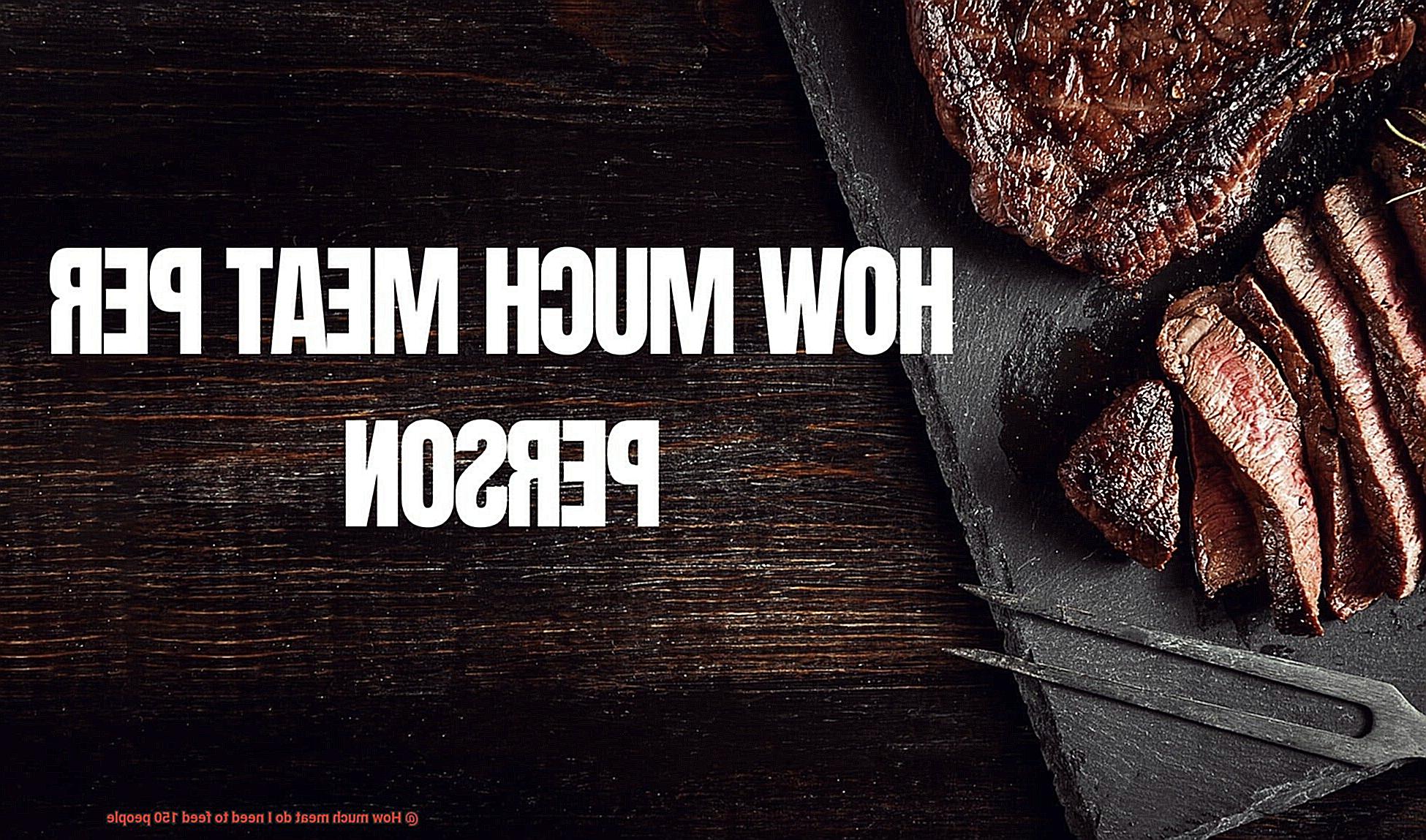
A helpful rule of thumb is to plan for about 1/2 pound of meat per person. This means for 150 people, you would need approximately 75 pounds of meat. Keep in mind that this can vary depending on factors such as the type of meat being served and the other dishes available.
Another vital consideration is any dietary restrictions or preferences among your guests. If you have a significant number of vegetarians or vegans attending, you may need to adjust your meat serving size accordingly.
To summarize, here are some general guidelines for determining portion sizes:
- Consider the type of meat being served and its serving size per pound
- Take into account the other dishes that will be served alongside the meat
- Plan for about 1/2 pound of meat per person
- Adjust accordingly for any dietary restrictions or preferences
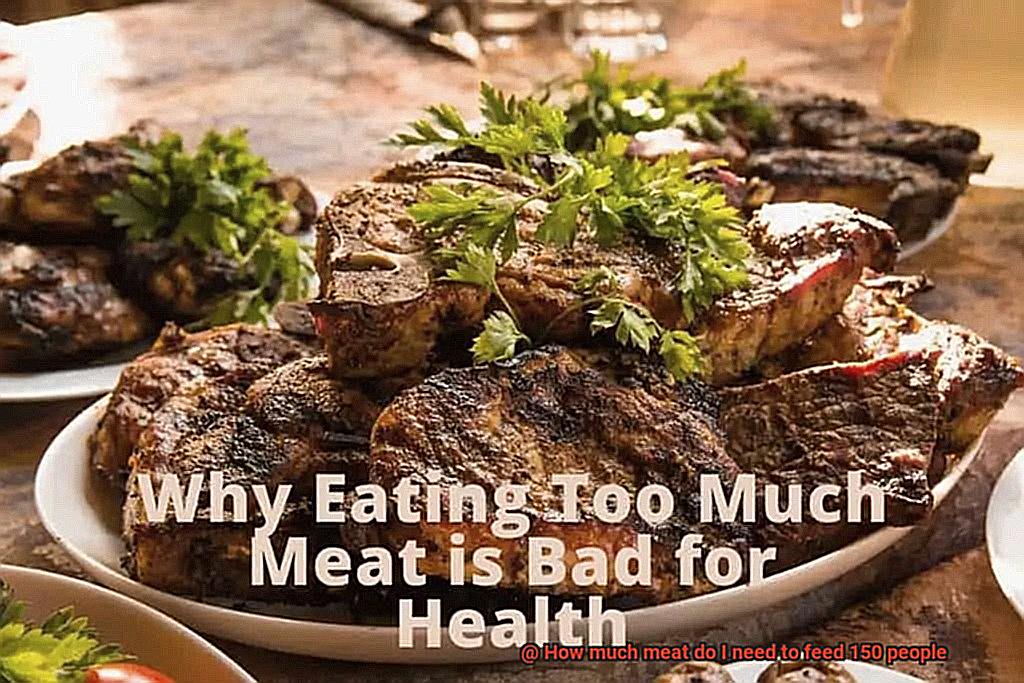
Allocating Meat Per Person
Then, it’s time to allocate meat per person. This crucial step ensures that everyone’s appetite is satisfied, without leaving anyone hungry or with a surplus of food. But how do you determine the amount of meat required for your event?
Firstly, consider the type of meat you will be serving. Beef, pork, chicken or fish? Once you’ve decided, calculate the appropriate amount of meat per person. As a rule of thumb, adults typically consume between 0.25 to 0.5 pounds of meat per serving while children may eat less.
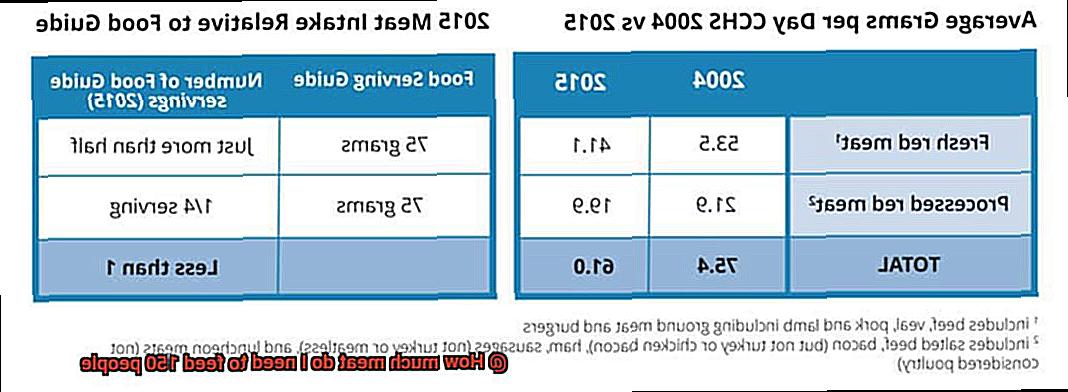
Let’s say you’re expecting 150 people. For beef or pork, allocate about 0.33 to 0.5 pounds per person. This means that for 150 people, you’ll need approximately 49.5 to 75 pounds of meat. For chicken or fish, allocate about 0.25 to 0.33 pounds per person; for 150 people, this equals approximately 37.5 to 49.5 pounds of meat.
But wait, there’s more. Consider the portion size when allocating meat per person. Adults may require larger portions than children; growing teenagers may eat more than an adult. So make sure to account for these differences in portion sizes.
Moreover, consider the age group of your attendees when determining the amount of meat required per person. Kids tend to eat less than adults; therefore, it might be best to allocate a bit less meat per child.
Varying the Allocation Depending on Type of Meat
Well, allocating the right amount of meat per person is crucial to make their taste buds dance with joy. But did you know that the allocation of meat can vary depending on the type and cut of meat you’re serving?
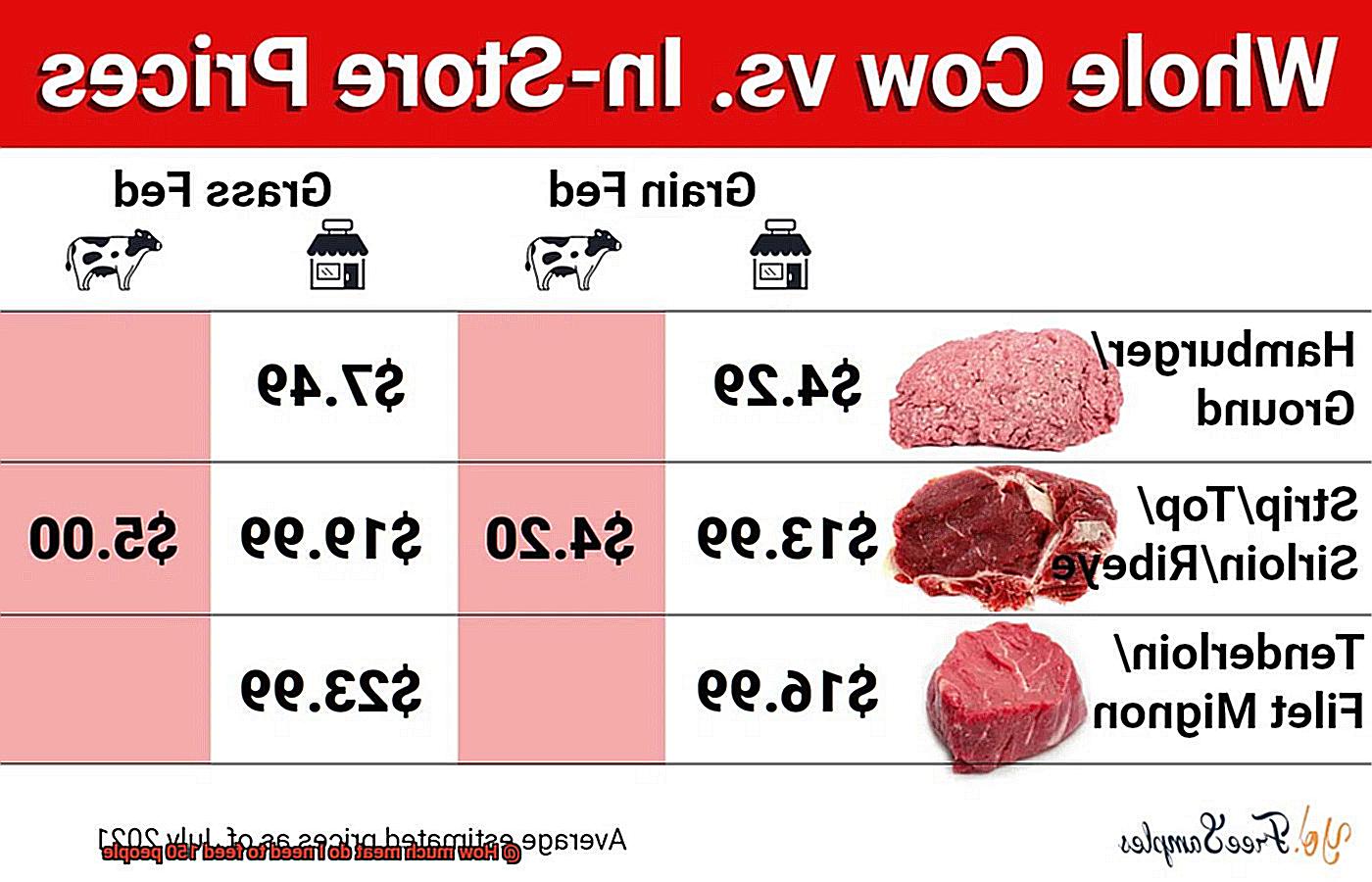
Different types of meat have different cooking times, shrinkage rates, and serving sizes. For example, beef has a shrinkage rate of around 25% after cooking, while pork or poultry has a higher shrinkage rate of around 40%. This means that you’ll need to buy more raw pork or poultry than beef to ensure everyone gets a reasonable serving size.
It’s also essential to consider the cut of meat you’ll be serving. Premium cuts like steak may require more meat per person than ground beef used in burgers or meatballs since they have a higher price point and are generally considered more desirable.
Here’s a quick breakdown on how to ensure everyone gets a satisfying meal:
Determine the type and cut of meat you’ll be serving.
Consider the expected shrinkage rate after cooking.
Allocate more meat for premium cuts like steak and less for ground meats mixed with other ingredients.
Use the rule of thumb of 0.25 to 0.5 pounds per serving as a starting point.
By following these simple guidelines, you can rest assured that your guests will leave with happy bellies and a memorable culinary experience.
To put things into perspective, let’s say you’re hosting an event for 150 people. If you’re serving beef, you’ll need about 75 pounds of raw beef to ensure everyone gets a reasonable serving size. However, if you’re serving pork or poultry, you’ll need about 120 pounds of raw pork or poultry to achieve the same result.
Adjusting Serving Size Based on Dishes Served
Planning a meal for a large group requires careful consideration, particularly when determining the amount of food needed. One crucial aspect to keep in mind is adjusting serving sizes based on the dishes served. To make sure your guests are well-fed and satisfied, here are some tips to help you plan an unforgettable culinary experience.
Consider the Type of Dish
The type of dish you’re serving will determine the amount of meat needed. For instance, if burgers are on the menu, you’ll require approximately 50-60 pounds of ground beef. For chicken breasts, around 75-90 pounds of chicken will suffice. By doing thorough research and adjusting accordingly, you’ll be able to serve up the perfect portion size.
Take Sides and Appetizers into Account
Don’t forget to factor in the sides and other dishes that will be served alongside the meat. If there will be plenty of sides like potato salad or coleslaw, you can reduce the meat amount required. This balancing act ensures that everyone has something delicious to eat and leaves feeling satisfied.
Portion Sizes Matter
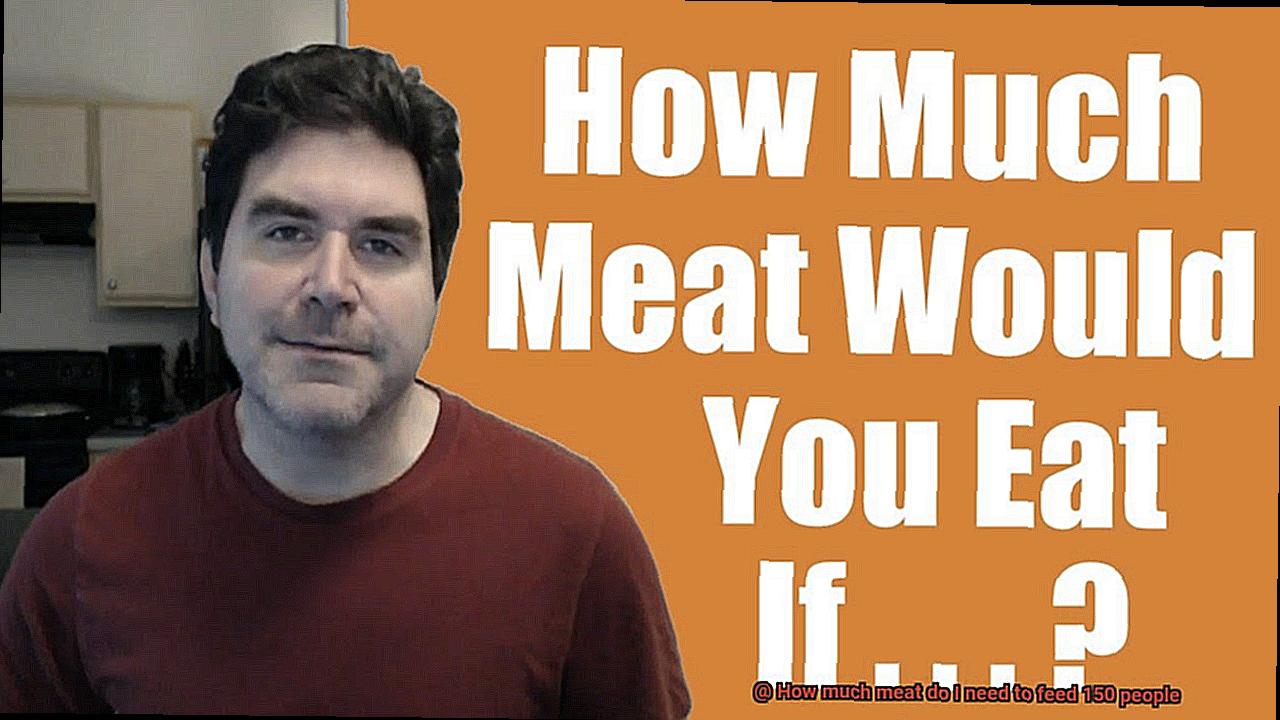
Portion size is another critical factor to consider when determining how much food to prepare. If you’re planning on large servings, more meat will be needed than if you’re serving smaller portions. As a general rule, plan on serving around 6-8 ounces of meat per person. This ensures that everyone has enough to eat without overindulging.
Don’t Forget Dietary Restrictions
It’s vital to take into account any dietary restrictions or preferences your guests may have. If there are vegetarians or vegans in your party, make sure there are plenty of non-meat options available. This guarantees that everyone can enjoy the meal without feeling left out or uncomfortable.
Taking Appetites Into Account
Feeding a large group of people can be quite a feat, but taking appetites into account is a crucial step to ensure that everyone is satisfied and well-fed. As an expert, I’ve compiled some research notes to help you plan a meal that will leave your guests feeling happy and content.
Firstly, consider the type of event you are hosting. Is it a formal dinner or a casual barbecue? Different events call for different amounts of meat per person. For instance, a formal dinner may require larger portions of meat, while a casual barbecue may offer more side dishes and smaller servings.
Next, think about the age range of your guests. Children typically eat less than adults, so you may need to adjust your quantities accordingly. Additionally, if you have any guests with dietary restrictions such as vegetarians or those who don’t eat pork, make sure to provide alternative options.
It’s also crucial to take into account the time of day and duration of the event. If it’s a long event with multiple meals, you may not need to serve as much meat per person for each meal. However, if it’s a shorter event with only one meal, you’ll want to make sure everyone is well-fed.
Lastly, leftovers are always an important consideration. While it’s better to have too much food than not enough, be mindful of how much you can realistically store or donate after the event.
Here are some sub-topics and lists to help guide you during your planning:
- Type of Event:
- Formal Dinner
- Casual Barbecue
- Age Range of Guests:
- Children
- Adults
- Dietary Restrictions:
- Vegetarians
- Non-Pork Eaters
- Time of Day and Duration:
- Long Event with Multiple Meals
- Short Event with Only One Meal
Tips for Calculating Accurately and Efficiently
Feeding a large group of people, such as 150 individuals, can be a daunting task. But don’t fret, we have some tips to help you calculate the right amount of meat needed to ensure everyone is well-fed and satisfied.
Tip #1: Use a Meat Calculator
A meat calculator is a helpful tool that can take into account various factors such as the type of meat, serving size, and the number of people being served. If you’re unsure how much meat to purchase, try using a meat calculator to make the process easier.
Tip #2: Consider the Type of Meat
Different meats have different yields and shrinkage rates, so it’s essential to consider this when calculating quantities. For instance, pork and beef have different yields, so you’ll need to purchase more pork than beef to feed the same number of people. Therefore, it’s necessary to factor in the type of meat you’ll be serving before making any calculations.
Tip #3: Calculate Per Person
It’s crucial to calculate the amount of meat needed per person accurately. A good rule of thumb is to plan for around 8 ounces of meat per person. However, this will vary depending on the type of meat being served and whether there are any vegetarians or vegans in the group. Hence, always keep in mind the number of servings when making calculations.
Tip #4: Plan for Leftovers
It’s always better to have too much food than not enough. Plan for leftovers by purchasing slightly more than what is needed. This will ensure that everyone is well-fed and happy. Plus, you can always use the leftover meat for sandwiches or other meals.
Tip #5: Consult with a Professional
If you’re still uncertain about how much meat to purchase, it’s best to consult with a professional caterer or butcher. They have extensive experience and expertise in calculating quantities, and they can provide you with accurate measurements based on your specific needs.
UmekXqJenWo” >
Conclusion
When it comes to feeding a crowd of 150 people, determining how much meat you need can be a daunting task. However, with some careful planning and calculations, you can ensure that everyone is well-fed and satisfied.
One important factor to consider is the type of meat you will be serving. For example, if you’re serving chicken or pork, you’ll need approximately 1/3 to 1/2 pound per person. If it’s beef or lamb, plan for 1/2 to 3/4 pound per person.
Another key consideration is whether or not you’ll be offering other protein options such as fish or vegetarian dishes. If so, adjust your meat quantities accordingly.
It’s also important to account for any potential leftovers or second helpings. While it’s always better to have too much food than not enough, try not to go overboard and waste resources.

